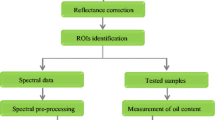Abstract
The oil content of oil sands is an important factor in oil sand resource evaluation. In this study, we use spectral reflectance to study the oil content parameter. The spectrograph can be used to determine the target spectral reflectance directly, using a fiber-optic probe, without destroying samples or using chemical reagents, which has the advantage of quick measurement and analysis. This paper documents the acquisition of hyperspectral data in the range of 350–2500 nm through spectrometry of oil sand samples. We process the original reflectivity data using the first-order and second-order differentials and then calculate and analyze the correlation coefficient with reflectivity of oil sands and the first and second derivatives of reflectance. Based on the characteristics of the correlation coefficient graphs, we determine the wave bands sensitive to oil content and verify that using hyperspectral data in the study of oil content is feasible.











Similar content being viewed by others
References
Chen, S., Zhao, L., & Wang, J. (2012). Study on hyperspectral response to surface alteration by oil and gas microseepage under loess area. Spectroscopy and Spectral Analysis, 32(6), 1616–1619.
Czarnecki, J., Radoev, B., Schramm, L. L., et al. (2005). On the nature of Athabasca oil sands. Advances in Colloid and Interface Science, 114–115, 53–60.
Ezeoke, M., & Tong, K. F. (2013). Modeling electromagnetic reflectivity of agbabu oil sand from hyperspectral infrared reflectance spectra and dielectric properties at L-, C- and X-band frequencies. In International conference on computational intelligence (pp. 125–130). IEEE.
Feng, J., Rivard, B., Gallie, A., et al. (2009). Feature selection and broad band bitumen content estimation of Athabasca oil sand from infrared reflectance spectra. In First workshop on hyperspectral image and signal processing: Evolution in remote sensing. WHISPERS’09 (pp. 1–5). IEEE.
Friesen, W. I. (1996). Qualitative analysis of oil sand slurries using on-line NIR spectroscopy. Applied Spectroscopy, 50(12), 1535–1540.
Huang, G., Wang, R., Shen, Z., et al. (2007). Prognosis of oil & gas exploration target areas by remote sensing technology. Geomatics & Spatial Information Thecnology, 30(2), 1–3.
Liu, D., & Qiu, X. (1991). Application of remote sensing technology in hydrocarbon exploration in eastern area of Zhunger basin. Petroleum Geology and Oilfield Development in Daqing, 1991(3), 77–78.
Long, Y., Tadeusz, D., & Hassan, H. (2004). Analysis of solvent-diluted bitumen from oil sands froth treatment using NIR spectroscopy. Canadian Journal of Chemical Engineering, 82(4), 776–781.
Lyder, D., Feng, J., Rivard, B., et al. (2010). Remote bitumen content estimation of Athabasca oil sand from hyperspectral infrared reflectance spectra using Gaussian singlets and derivative of Gaussian wavelets. Fuel, 89(3), 760–767.
Peng, J., Chi, C., Xiang, H., et al. (2014). Inversion of soil salt content based on continuum-removal method. Acta Pedologica Sinica, 51(3), 459–469.
Peng, J., Xiang, H., Zhou, Q., et al. (2013). Influence of soil iron oxide on VNIR diffuse reflectance spectroscopy. Spectroscopy and Spectral Analysis, 33(2), 502–506.
Rivard, B., Feng, J., Bushan, V., et al. (2011). Infrared reflectance hyperspectral features of Athabasca oil sand ore and froth. In 2011 3rd workshop on hyperspectral image and signal processing: Evolution in remote sensing (WHISPERS) (pp. 1–4). IEEE.
Rivard, B., Lyder, D., Feng, J., et al. (2010). Bitumen content estimation of Athabasca oil sand from broad band infrared reflectance spectra. The Canadian Journal of Chemical Engineering, 88(5), 830–838.
Salberg, A. B., Larsen, S. O., & Zortea, M. (2013). Multisource oil spill detection. Proceedings of SPIE—The International Society for Optical Engineering, 8892(6), 925–930.
Shan, X., Che, C., Li, J., et al. (2007). Present status of oil sand resources at home and abroad. Global Geology, 26(4), 459–464.
Shaw, R. C., & Kratochvil, B. (1990). Near-infrared diffuse reflectance analysis of Athabasca oil sand. Analytical Chemistry, 62(2), 167–174.
Van der Meer, F., Van Dijk, P., Van Der Werff, H., et al. (2002). Remote sensing and petroleum seepage: a review and case study. Terra Nova, 14(1), 1–17.
Wang, Y., & Ding, X. (1999). Hydrocarbon alteration characteristics and remote sensing mechanism of surface soil in East Sichuan. Geochimica (Beijing), 34(4), 381–392.
Xu, M., Yang, C., Liu, W., et al. (2015). Study on the character relationship between the density and susceptibility of the rock and reflection spectrum. Spectroscopy and Spectral Analysis, 35(8), 2225–2230.
You, J., Xing, L., Jun, P., et al. (2015). Research on oil sands spectral characteristics and the oil content of remote sensing estimation. Spectroscopy and Spectral Analysis, 4, 1025–1029.
Zhang, D., Tiyip, T., Zhang, F., et al. (2014). Application of fractional differential in preprocessing hyperspectral data of saline soil. Transactions Chinese Society of Agricultural Engineering, 30(24), 151–160.
Zhang, G. F., Shen, X. H., Zou, L. J., et al. (2007). Detection of hydrocarbon bearing sand through remote sensing techniques in the western slope zone of Songliao basin, China. International Journal of Remote Sensing, 28(8), 1819–1833.
Zhang, Z. (2004). The research of method techniques on mineral and rocks identification and analysis on the influence factors using imaging spectrometer remote sensing data. Beijing: China University of Geosciences.
Zhu, Z. (1994). Hydrocarbon microseepage theory and oil-gas reservoir detecting by remote sensing. Remote Sensing Technology and Application, (1), 1–10.
Acknowledgements
An Analytical Spectral Devices (ASD) spectrometer was used to perform the spectrum test in the laboratory. The oil content was determined at the China Chemical Geology and Mine Bureau Research Institute of Geology of Jilin Province.
Funding
The study was financially supported by National Science and Technology Major Project of the Ministry of Science and Technology of China (2011ZX05028-002), Science and Technology Project of PetroChina Company Limited (2013E-050102) and China Geological Survey Program (1212010761502).
Author information
Authors and Affiliations
Corresponding author
Ethics declarations
Conflicts of interest
Any conflicts of interest for any author are not apparent from their affiliation or funding.
About this article
Cite this article
Fan, R., Xing, L., Pan, J. et al. Study of the Relationship Between the Oil Content of Oil Sands and Spectral Reflectance Based on Spectral Derivatives. J Indian Soc Remote Sens 47, 931–940 (2019). https://doi.org/10.1007/s12524-018-0931-7
Received:
Accepted:
Published:
Issue Date:
DOI: https://doi.org/10.1007/s12524-018-0931-7




